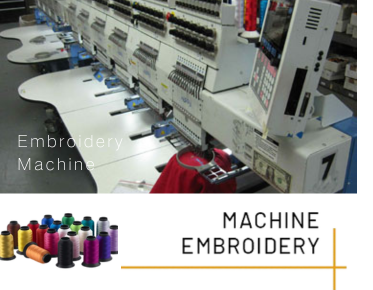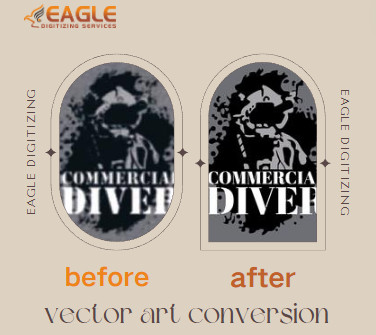Cultural Flair: Embedding Embroidery in Custom Apparel from Eagle Digitizing
In today's fashion world, blending tradition with modernity creates unique and meaningful garments. Embedding embroidery elements that reflect cultural heritage not only adds visual appeal but also tells a story. This guide explores how to incorporate culturally rich embroidery into custom apparel, blending age-old techniques with contemporary design. If this post piqued your curiosity and you wish to learn more about embroidery digitizing, feel free to reach out to us.
Why Cultural Embroidery Matters in Modern Fashion
Cultural embroidery is more than decorative art; it's a way to preserve and celebrate heritage. By integrating these intricate designs into modern fashion, we honor the craftsmanship and stories of different cultures, fostering a deeper connection to our roots.
Understanding Cultural Embroidery
What is Cultural Embroidery?
Cultural embroidery refers to the practice of using needlework to reflect the traditions, beliefs, and history of a particular community or ethnic group. Each stitch, color, and pattern holds significant meaning, making every piece a unique expression of cultural identity.
Historical Significance of Embroidery in Different Cultures
Embroidery has been a form of storytelling for centuries. In China, intricate silk embroidery showcases dragons and phoenixes symbolizing power and grace. In Mexico, vibrant floral patterns in Otomi embroidery celebrate nature and community. Each culture’s embroidery tells a story, preserving history in threads.
Common Motifs and Symbols in Cultural Embroidery
Common motifs in cultural embroidery include symbols of nature, spirituality, and daily life. For instance, Celtic knots represent eternity and interconnectedness, while Indian paisleys symbolize fertility and life. Understanding these symbols helps in creating authentic and respectful designs.
Selecting Embroidery Elements
Researching Cultural Designs
Start by researching the cultural designs you wish to incorporate. Look for reputable sources such as museums, cultural centers, and academic publications. Authenticity is key, so take time to understand the meaning behind each motif and pattern.
Choosing Authentic and Respectful Designs
Respect is paramount when borrowing from another culture. Choose designs that honor the tradition and avoid misappropriating sacred or significant symbols. When in doubt, consult with cultural experts or artisans from the community.
Combining Modern and Traditional Elements
Blend traditional motifs with modern design elements to create something fresh yet respectful. For example, pair traditional Japanese sashiko stitching with contemporary geometric patterns to produce a unique, culturally rich garment.
Materials and Tools for Cultural Embroidery
Selecting the Right Fabrics
The choice of fabric is crucial. Traditional fabrics like silk, cotton, and linen are often used in cultural embroidery. Ensure the fabric complements the design and has the right texture and strength for the embroidery technique.
Choosing Threads and Colors that Reflect Cultural Heritage
Threads should be selected to reflect the cultural significance of your design. Silk threads for Chinese embroidery or vibrant cotton threads for African designs are good examples. Pay attention to the traditional color palettes and their meanings.
Essential Tools for Embroidery Projects
Basic tools include embroidery hoops, needles, and thimbles. For more intricate work, consider using magnifiers and specialized lighting. Ensure you have a variety of needles suited for different types of thread and fabric.
Design Planning and Preparation
Sketching Your Design
Begin with a rough sketch of your design. This helps visualize the placement and proportion of the embroidery on the garment. Use this sketch to plan the colors and types of stitches you’ll use.
Digitizing Traditional Patterns
For precision, digitize your traditional patterns. Use embroidery software to convert your hand-drawn designs into digital files, which can then be used with embroidery machines for consistent results.
Positioning Embroidery Elements on Apparel
Carefully plan the placement of your embroidery elements. Consider the garment's structure and how the embroidery will interact with seams and other design features. Symmetry and balance are key to a visually appealing design.
Techniques for Embedding Cultural Embroidery
Hand Embroidery: A Traditional Approach
Hand embroidery allows for a personal touch and intricate detail. Techniques like satin stitch, chain stitch, and cross-stitch are staples in cultural embroidery. This method is labor-intensive but results in a unique and high-quality finish.
Machine Embroidery: Speed and Precision
Machine embroidery offers speed and consistency, making it ideal for larger projects. Modern machines can replicate complex patterns with high precision, ensuring each piece matches the original design.
Hybrid Techniques: Combining Hand and Machine Methods
Combining hand and machine embroidery can yield stunning results. Use the machine for base stitches and large areas, then add fine details and embellishments by hand for a rich, textured finish.
Customizing Apparel with Cultural Embroidery
Adding Embroidery to Different Types of Garments
From jackets to dresses, embroidery can enhance any garment. Consider the garment's use and fabric type when planning your design. Heavier fabrics like denim and canvas can handle bold, dense embroidery, while lighter fabrics like silk require more delicate stitching.
Creating Unique Patterns for Each Piece
Customize each piece by varying the placement, color, and scale of your embroidery. This makes every garment unique, ensuring no two pieces are exactly alike and enhancing the bespoke quality of your apparel.
Balancing Embroidery with Apparel Design
Ensure the embroidery complements the overall design of the garment. Balance busy patterns with solid colors and simple silhouettes, and use embroidery to highlight and enhance the garment's features.
Hooping and Stabilizing Cultural Embroidery
Hooping Techniques for Complex Designs
Proper hooping is essential for complex designs. Ensure the fabric is taut but not stretched to prevent distortion. For intricate designs, consider using a double-hooping technique to maintain stability.
Choosing the Right Stabilizer for Cultural Elements
Stabilizers provide the support needed to maintain the integrity of your design. Tear-away stabilizers are ideal for stable fabrics, while cut-away stabilizers offer strong support for stretch fabrics. Wash-away stabilizers are perfect for delicate materials.
Maintaining Fabric Integrity During Embroidery
Prevent fabric distortion by selecting the right hoop size and stabilizer. Avoid pulling the fabric too tightly and ensure the hoop is secure but not overly tight. Regularly check the fabric tension as you work.
Stitching Techniques for Cultural Embroidery
Basic Stitches Used in Cultural Embroidery
Master basic stitches like the backstitch, satin stitch, and French knot, which form the foundation of many cultural embroidery techniques. These stitches are versatile and can be adapted to various designs.
Advanced Stitching Techniques for Intricate Designs
For more intricate designs, learn advanced stitches such as the bullion knot, long and short stitches, and couching. These techniques add depth and complexity, making your embroidery stand out.
Embellishments and Accents
Adding Beads, Sequins, and Other Embellishments
Incorporate beads, sequins, and other embellishments to add texture and sparkle to your designs. Use these accents sparingly to enhance the embroidery without overwhelming it.
Using Metallic Threads for Extra Flair
Metallic threads add a touch of luxury and shine. They are perfect for highlighting key areas of your design and creating a rich, opulent effect. Use a suitable needle and adjust your tension to handle these specialty threads.
Incorporating Appliqué with Embroidery
Appliqué involves layering fabric pieces on top of the base fabric and securing them with embroidery. This technique adds dimension and contrast, making your designs more dynamic and visually appealing.
Color Theory in Cultural Embroidery
Choosing Colors that Represent Cultural Heritage
Colors hold significant meaning in many cultures. Research traditional color schemes and use them to ensure your designs are culturally accurate and respectful. For example, the use of reds and gold in Chinese designs for prosperity and happiness.
Creating Color Harmonies in Your Design
Create color harmonies by combining complementary and analogous colors. Use a color wheel to plan your palette and ensure a cohesive and visually pleasing design.
Practical Tips for Working with Color
Test your color combinations on a small fabric swatch before committing to the entire design. This helps you visualize the final result and make adjustments if necessary.
Caring for Culturally Embroidered Apparel
Washing and Drying Tips
Wash embroidered garments by hand or on a gentle machine cycle using mild detergent. Avoid wringing or twisting the fabric. Air dry flat to prevent distortion and preserve the embroidery.
Proper Storage Techniques
Store embroidered garments flat or rolled to avoid creases and distortion. If hanging, use padded hangers to maintain the shape. Keep them in a cool, dry area out of direct sunlight.
Repairing and Maintaining Embroidery
Regularly inspect your embroidery for loose threads or damage. Repair any issues promptly to prevent further damage. Use matching thread and a needle to carefully restitch or secure any loose areas.
Showcasing Your Work
Photography Tips for Embroidered Apparel
Use natural light and a neutral background to photograph your embroidered garments. Focus on the details to showcase the intricacy of your work. Experiment with different angles and close-ups.
Building a Portfolio of Cultural Embroidery
Create a portfolio to showcase your work. Include high-quality photos of your best pieces, along with descriptions of the materials, techniques, and cultural significance of each design.
Sharing Your Creations on Social Media
Share your embroidery on social media platforms like Instagram and Pinterest. Use relevant hashtags and engage with the embroidery community to reach a wider audience.
Ethical Considerations
Respecting Cultural Heritage and Avoiding Appropriation
Be mindful of cultural appropriation. Respect the origins and meanings of the designs you use. Acknowledge and credit the culture that inspired your work.
Collaborating with Cultural Artisans
Consider collaborating with artisans from the culture you are representing. This supports the community and ensures authenticity in your designs.
Educating Customers About Cultural Significance
Educate your customers about the cultural significance of the designs. This adds value to your work and fosters an appreciation for the heritage behind the embroidery.
Cultural embroidery is a beautiful way to celebrate and preserve heritage through fashion. By embedding these elements into custom apparel, we create garments that are not only aesthetically pleasing but also rich in meaning. Embrace the creative process and appreciate the cultural stories behind each design. This not only enriches your work but also fosters a deeper understanding and respect for different cultures.
Embark on your embroidery journey with curiosity and respect. Continue learning, experimenting, and sharing your work. Each stitch is a step towards preserving and celebrating the rich tapestry of human culture.



